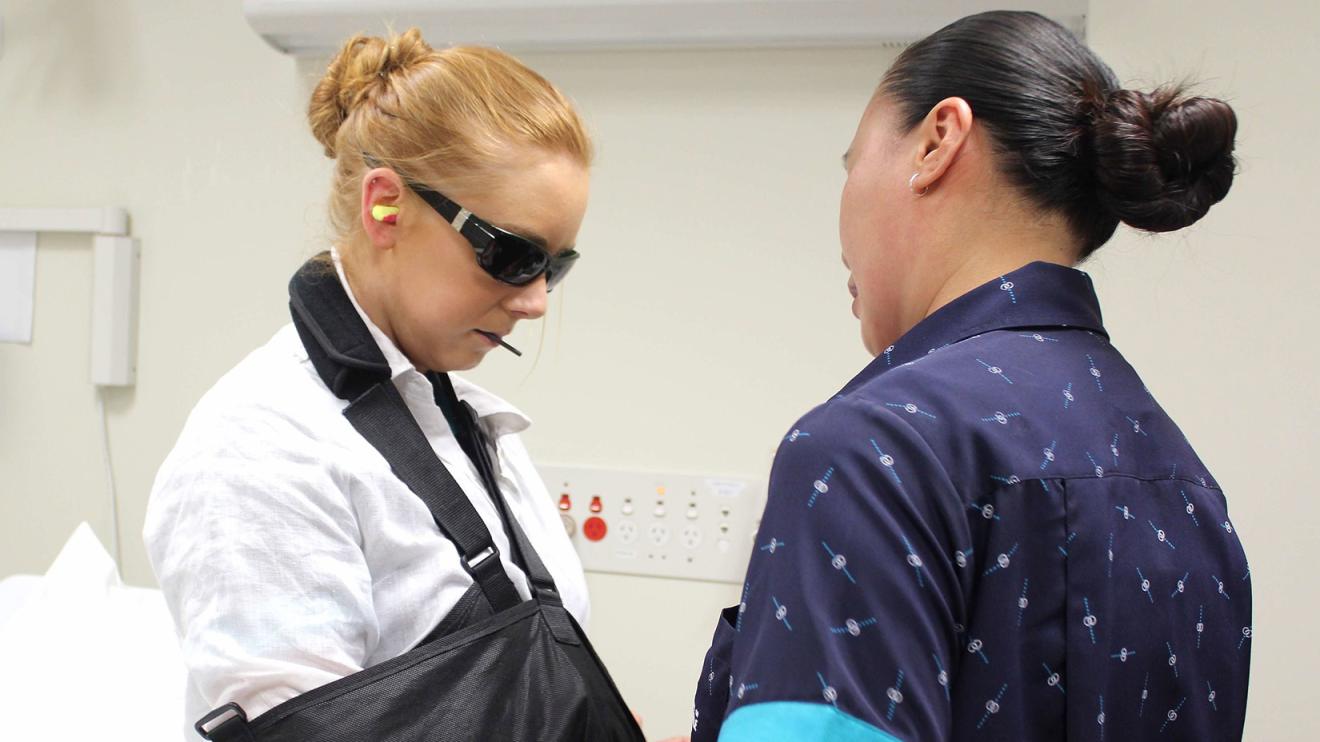Studies show that in the general population there has been a 40 per cent decline in empathy levels over the last 30 years. In healthcare, diminished levels of empathy can have a significant impact on patients' and staff emotional and physical wellbeing.
Against this background the Empathy Initiative (opens external site) research group was formed in 2017.
"The aim of our research group is to conduct high quality, rigorous empathy and compassion research that informs and transforms student learning and patient care," says Distinguished Professor Tracy Levett-Jones, lead of the group and Professor of Nursing Education, from the UTS School of Nursing and Midwifery.
"Before the establishment of the Empathy Initiative, there were some academics in the school conducting empathy research.
"But we wanted to harness our collective strengths, collaborate and promote our research in ways that would impact both education and healthcare.
Since 2017, our research has continued to expand and it is having a significant impact on students' and clinicians' empathy levels, both in Australia and internationally.
Improved patient outcomes
A few examples of our research are the work conducted by Dr Samantha Jakimowicz on intensive care nurses' compassion fatigue; Dr Fiona Orr's research on hearing distressing voices simulations; and Sue Dean's work on the impact of mindfulness on learners' empathy levels.
"What drives each of us, is the knowledge that empathic healthcare interactions can have a measurable impact on patient outcomes," says Distinguished Professor Levett-Jones.
"We don't know the precise cause for this, but one hypothesis is that empathy reduces the stress response and cortisol production and therefore aids healing and promotes wellbeing."
Empathy statistics
- 52% higher patient satisfaction with healthcare when clinicians demonstrate empathy.
- 93% of patients believe that a lack of empathy lowers the quality of care.
- 1% of patients describe their interactions with healthcare professionals as empathic encounters.
- 50% reduction in post-operative morphine requirements following an empathic pre-operative consultation.
- 50% decline in nursing and medical students’ empathy levels while enrolled in an undergraduate healthcare degree.
- 20% reduction in pain, depression and anxiety when healthcare consultations convey empathy.
- 25% higher levels of cellular immunity in patients with lung cancer when cared for by oncology nurses with high levels of empathy.
- 42% reduction in emergency department visits from diabetic patients after empathetic interactions with doctors.
The Virtual Empathy Museum
One of the first collaborative projects undertaken by members of the Empathy Initiative Research Group was the design of the Virtual Empathy Museum (opens external site).
Funded by an Australian Technology Network Strategic Initiative Grant, the museum is a unique, engaging and experiential open access resource that uses the architecture of a virtual tour, virtual journeys and virtual experiences.
The museum is divided into seven digital 'rooms' (film, reading, art, simulation, digital storytelling, resource and meditation).
Each provides a set of authentic and evidence-based learning and teaching resources that can be used in flexible and creative ways to enhance healthcare students' and clinicians' empathy skills.
Inside the Virtual Empathy Museum
The Virtual Empathy Museum (opens external site) is comprised of seven virtual rooms in which multi-sensory digital artefacts and information resources have been curated to enhance healthcare students' and clinicians' empathy skills.
Digital storytelling room
Digital stories designed to promote learners' empathic reflection and a re-examination of attitudes towards people from a range of marginalised backgrounds. The stories are multidimensional in nature and enable exploration of reality from different perspectives.
Simulation room
Simulation toolkits and rich media artefacts that allow learners to 'stand in the patient's shoes'. They create a unique vantage point from which learners can see the world through the eyes of another person in order to gain new insights into their feelings, perspectives and needs.
Meditation room
An introduction to the practice of mindfulness and meditation as strategies to promote empathic humility, improve self-awareness and reduce compassion fatigue.
Art room
Examples of works of art designed to foster learners' empathic curiosity and creativity. The study of art enhances the ability to 'read' people and interpret the subtle nuances of facial expressions and body language.Reading room
Examples of fictional and non-fictional works of literature that can be used to enhance learners' aesthetic knowledge, empathic imagination and perspective taking. Learning to appreciate the nuance, symbolism and deeper layers of meaning in a story can promote emotional engagement with and about critical issues.
Film room
Film reviews designed to enhance learners' empathic intelligence and appreciation of the lived experience of illness. The human stories portrayed in the films engage learners and promote vicarious learning experiences in ways that inspire, educate and transform.
Resource room
Links to a collection of high-quality web-based multimedia resources, each designed to enhance empathic imagination and empathic intelligence. Both generic empathy resources and those that focus specifically on vulnerable patient groups are included.
Long-lasting changes
"Empathy is both a trait and a state," Distinguished Professor Levett-Jones says.
"Our research has demonstrated that state empathy can be taught through the arts and through experiential learning approaches such as simulation.
"For example, the immersive simulations in the Virtual Empathy Museum provide learners with an opportunity to 'walk in the shoes' of an older person, someone who hears distressing voices, a person who has had a stroke or is from a non-English speaking background.
"We have identified significant and long-lasting changes in learners’ empathy levels following exposure to these types of meaningful encounters.
"Our research projects often focus on marginalised and stigmatised groups – people who are homeless, refugees, those who have a mental illness, people with a disability or with alcohol and other drugs addictions, for example.
These are the people who need empathic healthcare the most but are least likely to receive it.
Constantly evolving
The Virtual Empathy Museum is used by individuals, universities and healthcare organisations across Australian and internationally.
It is constantly evolving, and current projects include the development of a series of new digital stories and animations and a systematic review examining the impact of curriculum co-design with lived experience experts on learners' empathy levels.
The Empathy Initiative Research Group has grown from the initial seven members to 15 and continues to undertake collaborative projects focused on improving empathic patient care.
Distinguished Professor Levett-Jones says the research was focused on outcomes, and designed to have a meaningful impact on clinical practice.
Because as Professor Jodi Halpern from UC Berkeley Public Health Faculty, advocates: "Empathy without action is not empathy."
-

-
Professor of Nursing Education, School of Nursing and Midwifery
-
Senior Lecturer, School of Nursing and Midwifery





